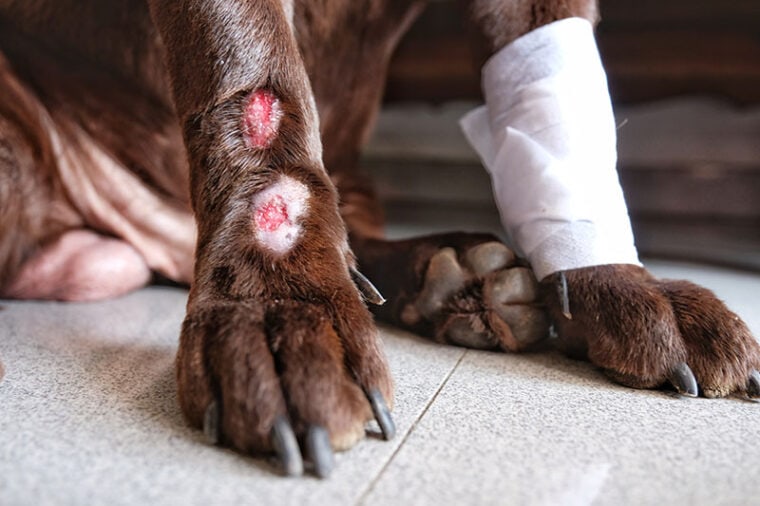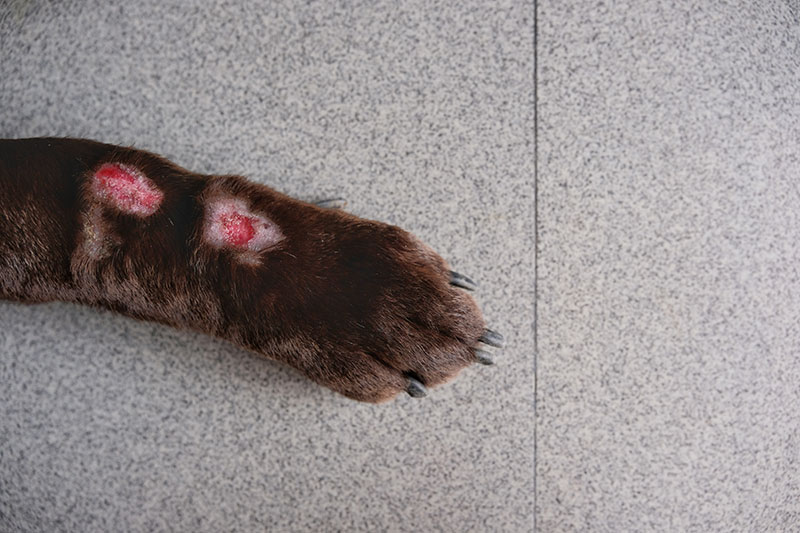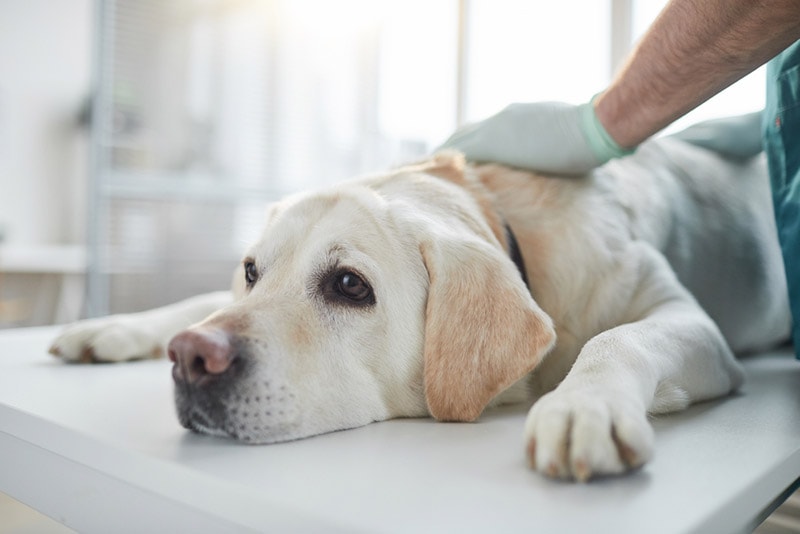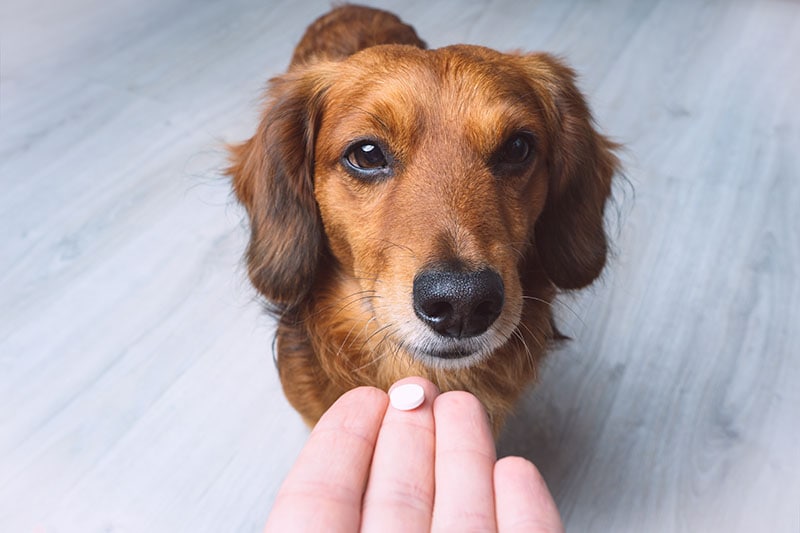
What do lick granulomas, acral lick dermatitis, and acral lick granuloma all have in common? Well, all three terms are actually various names for the same medical condition. This diagnosis affects dogs’ skin, typically in key areas, that comes about because of repetitive licking over a chronic (long) period of time.
In this article, we’ll learn more about these lesions, how dogs can get this condition, as well as observed signs and potential treatment options.
What Is a Lick Granuloma?
Acral is a Greek word that translates to “the top part of the extremities” while granuloma can mean “a raised lesion that is made of inflamed tissue.” Furthermore, dermatitis means “inflammation of the skin” and so, all together, these terms give us a full picture—in that the skin of the extremities can get a raised and inflamed lesion due to licking.
The affected area in this condition is self-traumatic due to the obsessive licking or chewing of the lesions(s) over and over again. Keep in mind that repeated licking of even normal (i.e., not diseased) skin on an area of a dog’s body brings about a circular pattern of inflammation, infection, and self-trauma. Thus, when confronted with this condition, we often see a “chicken and the egg” paradox; which came first, the lesion or the licking?
While we’ll discuss some of the causes of the licking further along in the article, it is typically thought to be due to either (or in combination with) medical disease and/or psychological causes.

The lesions themselves are most commonly seen at the lower ends of the extremities on the superficial surface of the skin. The areas most likely affected are the top part of the carpus (wrist), metacarpus (between the wrist and toes on front feet) followed by the tarsus (ankle), or metatarsus (between the ankle and toes on back feet). There is usually one main lesion, but they can sometimes occur in more than one place.
It has been theorized that while repeated licking can actually cause the nerves in that area to become damaged, the action of licking can also release endorphins (feel-good hormones) which can aid with pain control and help provide feelings of comfort 1.
The affected areas often appear and progress over a long period of time and can relapse fairly easily. This condition is more commonly seen in larger breed dogs and can often be most notably observed in Doberman Pinschers, Labrador Retrievers, Great Danes, Weimaraners, and Golden Retrievers. The age of onset can vary, especially depending on the cause.
What Are the Signs of a Lick Granuloma?
Signs that are observed in dogs with a lick granuloma will be in the specific areas as discussed and can include:
What Are the Causes of a Lick Granuloma?

As mentioned, compulsive licking over time is what contributes to a lesion that leads to inflammation and infection. This in turn makes the area itch even more, which starts a vicious cycle. All the while, this “itch-lick” cycle prevents the area from being able to heal. Licking may be caused by either a medical disease that promotes initial pain or initial itching at the affected location, or by psychological causes that result in the initial repetitive licking. In some cases, no exact cause is found.
How Do I Care for a Dog with a Lick Granuloma?
At the veterinary clinic, a complete history and physical exam will be the first steps. A veterinarian will then use the history, their physical exam findings, and the location and appearance of the lesion as clues to determine the next steps. Depending on many factors, various tests may need to be used to rule potential causes in or out. Some tests that may be recommended could include skin scraping and cytology, fungal culture, food trial, culture and sensitivity, biopsy, or X-ray.
Treatment Options
The treatment will be determined by the cause as well as the severity of the lesion. Trying to heal the lesion and prevent continual licking is likely to be a multifaceted endeavor that takes time and patience. Your veterinarian will weigh all the factors and causes and discuss game-plan options that are best for your pet and that can fit in with your lifestyle.
Medication
For the itch factor, there are various oral, topical, and injectable options that may even be used in combination depending on the severity of the lesion and the discomfort. If there is a pain component like in arthritis, there are also veterinary-prescribed dog-safe NSAIDs (nonsteroidal anti-inflammatory drugs) that may be used shortly after but not concurrently with steroids.
A bacterial infection will be treated with antibiotics while a lesion that has a fungal infection will be treated by antifungals. These medications may be prescribed for many weeks to months. Behavioral medications such as selective serotonin reuptake inhibitors (SSRIs, for example, Fluoxetine) or tricyclic antidepressants (for example, Clomipramine) may be needed to help with compulsive behavior. Some types of laser therapy and even acupuncture have been of help in some cases.

Mental Stimulation
Other treatment considerations include making sure the affected dog is receiving adequate mental stimulation, physical exercise, and attention. For short-term use, an Elizabethan collar (e-collar), bandage, topical bitter apple sprays, or a basket muzzle can act as a physical barrier to keep the dog away from the lesion as it is healing, and they are learning to leave the area alone.
For tough cases, working with other specialists such as a board-certified veterinary dermatologist or veterinary behavioral specialist may be needed.
Frequently Asked Questions
Can this be spread to other dogs or people?
The answer here is it will depend on the specific cause of the lesion. Most of the time, this type of lesion is not transferable to others (dogs or people). In rare cases, dermatophytosis (a fungal infection) or another contagious cause of the lesion could spread but again, this is not a common occurrence.
Will my dog ever get better?
In general, lick granulomas can be difficult to treat but positive results can often be achieved with proper treatment combinations. Relapse can also be common. If there is a medical cause, it is important to implement treatment depending on the cause.
In addition, it’s of the utmost importance to prevent the dog from continuing to get to the affected area to allow healing and retrain their compulsive behavior.

Conclusion
Lick granulomas can be a difficult skin lesion to treat that may require multifaceted treatment. It’s important to stop the scratch-itch-lick cycle as well as treat any infected lesion properly. If you notice your dog licking a specific area repeatedly, with some help from your dog’s doctor, prompt diagnosis and treatment can result in a positive resolution of this condition.
Featured Image Credit: PolyPloiid, Shutterstock









